外研版(2019)选择性必修第一册Unit 5 Revealing nature Listening & speaking课件 (共29张PPT,内镶嵌视频)
文档属性
| 名称 | 外研版(2019)选择性必修第一册Unit 5 Revealing nature Listening & speaking课件 (共29张PPT,内镶嵌视频) | 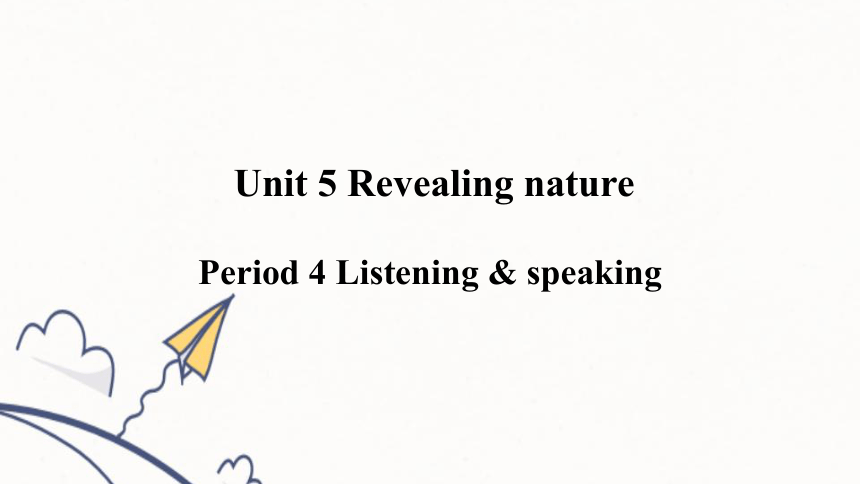 | |
| 格式 | pptx | ||
| 文件大小 | 54.5MB | ||
| 资源类型 | 教案 | ||
| 版本资源 | 外研版(2019) | ||
| 科目 | 英语 | ||
| 更新时间 | 2024-10-11 15:28:20 | ||
图片预览

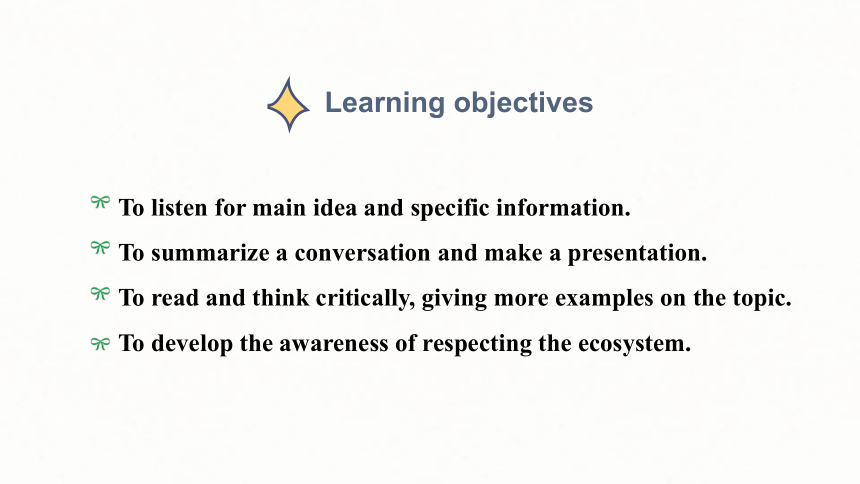

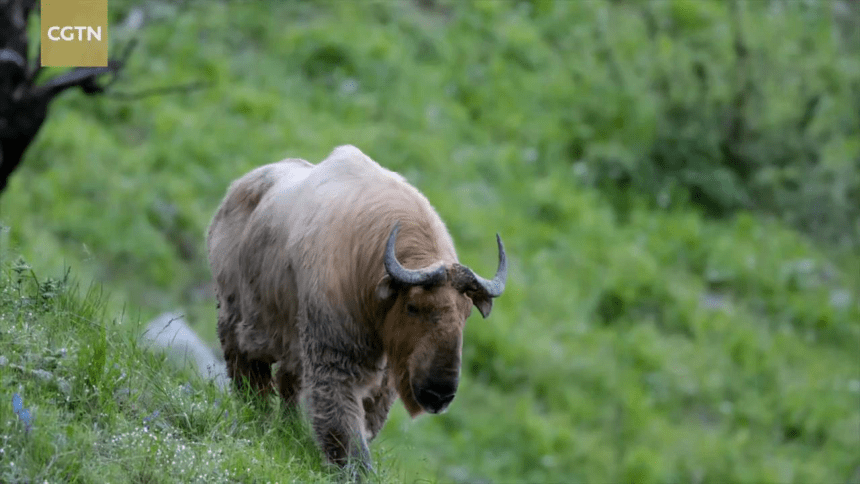
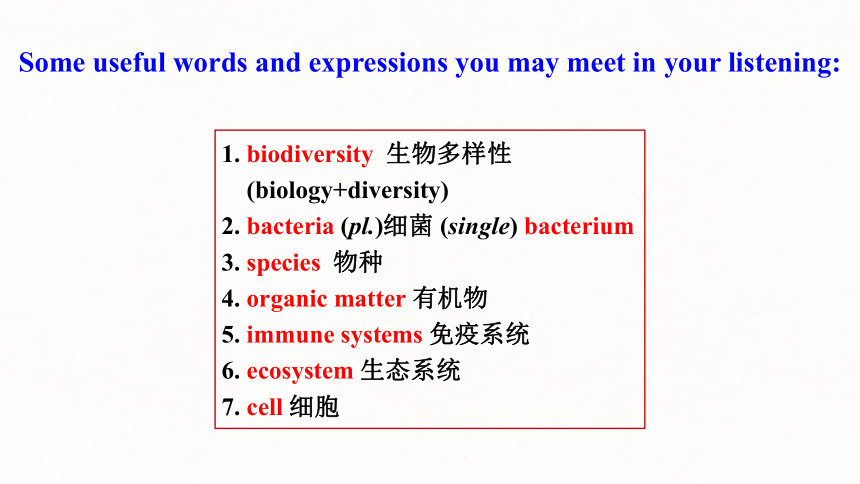
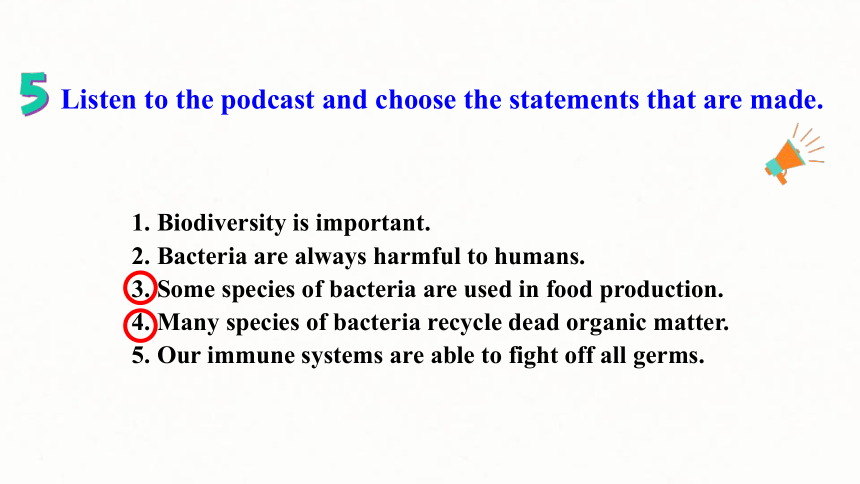
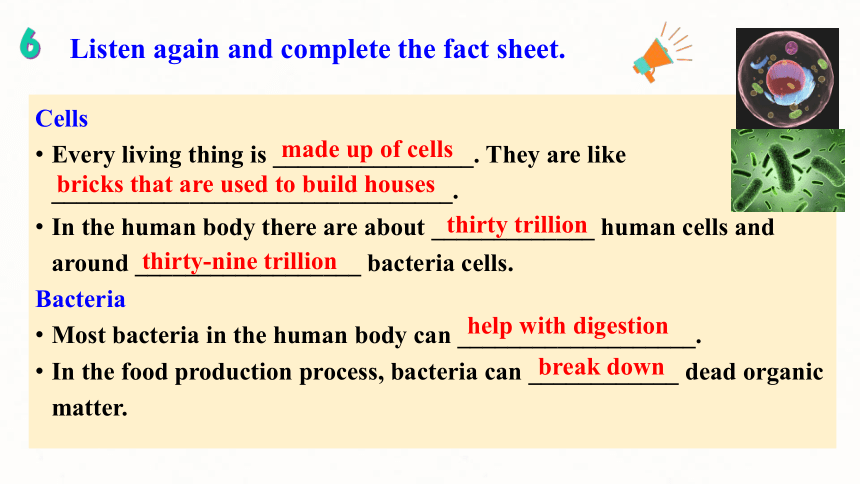


文档简介
(共29张PPT)
Unit 5 Revealing nature
Period 4 Listening & speaking
To listen for main idea and specific information.
To summarize a conversation and make a presentation.
To read and think critically, giving more examples on the topic.
To develop the awareness of respecting the ecosystem.
Learning objectives
March 3rd marks World Wildlife Day, a day
dedicated by the United Nations to raise awareness for the protection of wildlife and biodiversity, which are essential to human survival. The 2022 theme will be “Recovering Key Species for Ecosystem Restoration”. Enjoy a video.
What is biodiversity
Pre-listening
1. biodiversity 生物多样性
(biology+diversity)
2. bacteria (pl.)细菌 (single) bacterium
3. species 物种
4. organic matter 有机物
5. immune systems 免疫系统
6. ecosystem 生态系统
7. cell 细胞
Some useful words and expressions you may meet in your listening:
Listen to the podcast and choose the statements that are made.
1. Biodiversity is important.
2. Bacteria are always harmful to humans.
3. Some species of bacteria are used in food production.
4. Many species of bacteria recycle dead organic matter.
5. Our immune systems are able to fight off all germs.
Listen again and complete the fact sheet.
Cells
Every living thing is ________________. They are like ________________________________.
In the human body there are about _____________ human cells and around __________________ bacteria cells.
Bacteria
Most bacteria in the human body can ___________________.
In the food production process, bacteria can ____________ dead organic matter.
made up of cells
bricks that are used to build houses
thirty trillion
thirty-nine trillion
help with digestion
break down
Now work in pairs. Discuss what you know about cells and bacteria.
Complete the boxes with the expressions from the podcast.
Checking background knowledge
Do you know about... Have you heard of ...
By the way, … In fact,....
Actually, .... Speaking of which, ...
Adding information
Do you know about...
Have you heard of ...
By the way, …
Actually, ....
In fact,....
Speaking of which, ...
Read the passage and answer the questions.
What species are mentioned and what is special about them
2. What other unusual life forms do you know of
Two species are mentioned: the blue whale and the water bear. The blue whale is the largest animal species on Earth, which can grow up to almost 30 metres in length and weigh over 130,000 kilos. The water bear is probably the toughest species, which can survive temperatures from 150℃ to below freezing -272℃.
Complete the paragraphs with the correct form of the words and expressions.
ancestor scientific be native to primitive habitat appearance be home to ecosystem
1
2
3
1
The Galapagos Islands are renowned worldwide for their unique biodiversity. The Giant Tortoise Reserve on Santa Cruz (1) __________ several species of giant tortoise that (2) ____________ the Galapagos Islands. The island is also home to the Charles Darwin Research Station, where (3) ___________ studies are carried out.
is home to
are native to
scientific
2
Mangroves are one of the coastal plants that grow on Isabela. They serve as the (4) _________ for various birds and fish, and are very important to the (5) ___________.
3
Iguanas can be found on San Cristobal. They have a very special (6) __________, with comb-like spines on their back. There is evidence that all the different iguanas have developed from more (7) _________ ones and share a common (8) _________.
habitats
ecosystem
appearance
primitive
ancestor
Look at the pictures of the species native to different regions of China. Talk about biodiversity in China using the words and expressions in this section. Do online research to find more information.
Have you ever heard of the peacock in the southwestern China
I know the habitat of them is hot and wet areas. Do you know anything about the appearance of them
Useful expressions:
species
ecosystem
biodiversity
scientific
primitive
habitat
appearance
be native to …
Supplementary information
The mammal yaks can live in the highest plateau, mainly in the Himalayas and Tibetan Plateau. Yaks, usually dark brown or black in color, have very long and thick fur covered all their bodies. Their limbs are short but strong. All these characteristics make yaks can live in the area of 3000-5000 metres above sea level and 30-40 degrees below zero. Nearly 85% of yaks in the world
are living in China.
Diversiform-leaved poplar trees (胡杨林) mainly grow in 20 countries, including Mongolia and some on the Mediterranean. Xinjiang grows 91 percent of diversiform-leaved poplar trees in China. The trees are estimated to have a history of three million years, according to its fossils found in 1935 in Xinjiang and neighboring Gansu province.
However, During the 1960-1970 period, large areas of diversiform-leaved poplar trees were felled (砍伐树木) in some areas in Xinjiang to make room for farming, greatly deteriorating the local ecological environment with desert incursion into oases (绿洲). Introduction of laws and policies, along with increasing protection awareness among the public, have
kept the rare trees from destruction.
Peacocks are mainly found in Yunnan province, in the southwest of China. According to a survey by the Kunming Institute of Zoology, part of the Chinese Academy of Sciences, fewer than 500 of the green peacocks may still exist, and it has now become one of China’s most endangered wildlife species, even rarer than the giant panda.
Siberian tigers, otherwise known as Amur or Manchurian tigers, mainly live in eastern Russia, Northeast China and the northern part of the Korean Peninsula. Forest and mountain areas in the eastern part of Jilin have long been the habitat for
Siberian tigers, and a monitoring center has been
established covering 500 square meters to keep
track of the animals.
In recent years, wild Siberian tigers have been sighted frequently in the region thanks to its improving natural environment. Official statistics show Jilin currently has 42 nature reserves covering 2.61 million hectares (公顷) of land, and accounting for 13.9 percent of all land of Jilin.
Dawn redwood trees (水杉) are large fast-growing Chinese monoecious (雌雄同株的) tree having flat bright-green deciduous (树木每年落叶的) leaves and small globular cones (球果) .
Also known as the metasequoia, the tree is native to Hubei, Hunan and Sichuan provinces and widely regarded as a living fossil since its existence dates back to the Cretaceous (白垩纪的) period, but has been planted in a vast regions across China that are south of Beijing in recent years to be used for harvesting and for ornament.
It has high academic value as one precious relic plant.
Now talk about what methods you used to collect the information pare your methods with your partner’s and think about which methods are more efficient.
How many species did you learn
What is special about them
How can we check background knowledge or add information in a conversation
What is biodiversity in your mind now
I. 根据句意及提示,写出该单词的正确形式(每空一词)。
1. Living conditions in the camp were pretty ________ (原始的).
2. His interest in the project ________ ( 减少) after his wife died.
3. In 2009, researchers produced a clone of the extinct ________ (山羊) species Pyrenean ibex.
4. Officials believe that more than one person may be to ________ (责怪) for the fire.
5. The male bird displays several c_______________ which distinguish him from the female.
primitive
declined
goat
blame
characteristics
Exercises
1. It's known to us that the kangaroos_____________ Australia.
2. I wish he could afford to __________ his plan.
3. Have you _________ a TV program called Lie to Me It is very popular.
4. —Are you ready for the party tomorrow
—Yeah, I am! ________________, did you buy the cake yet
are native to
II. 用方框内合适的短语并用其正确形式填空。
by contrast, speak of, fight off, by the way, carry out,
hear of, be native to
carry out
heard of
By the way
5. I think we've discussed everything we need to — ____________ which, what time is it
6. I was trying to ___________ the urge to go to the kitchen secretly for something to eat.
7. In the south much of the land is flat. ____________, in the north there are hills and mountains everywhere.
speaking of
fight off
By contrast
by contrast, speak of, fight off, by the way, carry out,
hear of, be native to
Illustrate another unusual life form and biodiversity in China. You may use the newly learned words and expressions:
some species, organic matter, germ, bacteria, cell, be home to, be native to, primitive, ancestor, ecosystem, by the way, in fact, actually...
Homework
Unit 5 Revealing nature
Period 4 Listening & speaking
To listen for main idea and specific information.
To summarize a conversation and make a presentation.
To read and think critically, giving more examples on the topic.
To develop the awareness of respecting the ecosystem.
Learning objectives
March 3rd marks World Wildlife Day, a day
dedicated by the United Nations to raise awareness for the protection of wildlife and biodiversity, which are essential to human survival. The 2022 theme will be “Recovering Key Species for Ecosystem Restoration”. Enjoy a video.
What is biodiversity
Pre-listening
1. biodiversity 生物多样性
(biology+diversity)
2. bacteria (pl.)细菌 (single) bacterium
3. species 物种
4. organic matter 有机物
5. immune systems 免疫系统
6. ecosystem 生态系统
7. cell 细胞
Some useful words and expressions you may meet in your listening:
Listen to the podcast and choose the statements that are made.
1. Biodiversity is important.
2. Bacteria are always harmful to humans.
3. Some species of bacteria are used in food production.
4. Many species of bacteria recycle dead organic matter.
5. Our immune systems are able to fight off all germs.
Listen again and complete the fact sheet.
Cells
Every living thing is ________________. They are like ________________________________.
In the human body there are about _____________ human cells and around __________________ bacteria cells.
Bacteria
Most bacteria in the human body can ___________________.
In the food production process, bacteria can ____________ dead organic matter.
made up of cells
bricks that are used to build houses
thirty trillion
thirty-nine trillion
help with digestion
break down
Now work in pairs. Discuss what you know about cells and bacteria.
Complete the boxes with the expressions from the podcast.
Checking background knowledge
Do you know about... Have you heard of ...
By the way, … In fact,....
Actually, .... Speaking of which, ...
Adding information
Do you know about...
Have you heard of ...
By the way, …
Actually, ....
In fact,....
Speaking of which, ...
Read the passage and answer the questions.
What species are mentioned and what is special about them
2. What other unusual life forms do you know of
Two species are mentioned: the blue whale and the water bear. The blue whale is the largest animal species on Earth, which can grow up to almost 30 metres in length and weigh over 130,000 kilos. The water bear is probably the toughest species, which can survive temperatures from 150℃ to below freezing -272℃.
Complete the paragraphs with the correct form of the words and expressions.
ancestor scientific be native to primitive habitat appearance be home to ecosystem
1
2
3
1
The Galapagos Islands are renowned worldwide for their unique biodiversity. The Giant Tortoise Reserve on Santa Cruz (1) __________ several species of giant tortoise that (2) ____________ the Galapagos Islands. The island is also home to the Charles Darwin Research Station, where (3) ___________ studies are carried out.
is home to
are native to
scientific
2
Mangroves are one of the coastal plants that grow on Isabela. They serve as the (4) _________ for various birds and fish, and are very important to the (5) ___________.
3
Iguanas can be found on San Cristobal. They have a very special (6) __________, with comb-like spines on their back. There is evidence that all the different iguanas have developed from more (7) _________ ones and share a common (8) _________.
habitats
ecosystem
appearance
primitive
ancestor
Look at the pictures of the species native to different regions of China. Talk about biodiversity in China using the words and expressions in this section. Do online research to find more information.
Have you ever heard of the peacock in the southwestern China
I know the habitat of them is hot and wet areas. Do you know anything about the appearance of them
Useful expressions:
species
ecosystem
biodiversity
scientific
primitive
habitat
appearance
be native to …
Supplementary information
The mammal yaks can live in the highest plateau, mainly in the Himalayas and Tibetan Plateau. Yaks, usually dark brown or black in color, have very long and thick fur covered all their bodies. Their limbs are short but strong. All these characteristics make yaks can live in the area of 3000-5000 metres above sea level and 30-40 degrees below zero. Nearly 85% of yaks in the world
are living in China.
Diversiform-leaved poplar trees (胡杨林) mainly grow in 20 countries, including Mongolia and some on the Mediterranean. Xinjiang grows 91 percent of diversiform-leaved poplar trees in China. The trees are estimated to have a history of three million years, according to its fossils found in 1935 in Xinjiang and neighboring Gansu province.
However, During the 1960-1970 period, large areas of diversiform-leaved poplar trees were felled (砍伐树木) in some areas in Xinjiang to make room for farming, greatly deteriorating the local ecological environment with desert incursion into oases (绿洲). Introduction of laws and policies, along with increasing protection awareness among the public, have
kept the rare trees from destruction.
Peacocks are mainly found in Yunnan province, in the southwest of China. According to a survey by the Kunming Institute of Zoology, part of the Chinese Academy of Sciences, fewer than 500 of the green peacocks may still exist, and it has now become one of China’s most endangered wildlife species, even rarer than the giant panda.
Siberian tigers, otherwise known as Amur or Manchurian tigers, mainly live in eastern Russia, Northeast China and the northern part of the Korean Peninsula. Forest and mountain areas in the eastern part of Jilin have long been the habitat for
Siberian tigers, and a monitoring center has been
established covering 500 square meters to keep
track of the animals.
In recent years, wild Siberian tigers have been sighted frequently in the region thanks to its improving natural environment. Official statistics show Jilin currently has 42 nature reserves covering 2.61 million hectares (公顷) of land, and accounting for 13.9 percent of all land of Jilin.
Dawn redwood trees (水杉) are large fast-growing Chinese monoecious (雌雄同株的) tree having flat bright-green deciduous (树木每年落叶的) leaves and small globular cones (球果) .
Also known as the metasequoia, the tree is native to Hubei, Hunan and Sichuan provinces and widely regarded as a living fossil since its existence dates back to the Cretaceous (白垩纪的) period, but has been planted in a vast regions across China that are south of Beijing in recent years to be used for harvesting and for ornament.
It has high academic value as one precious relic plant.
Now talk about what methods you used to collect the information pare your methods with your partner’s and think about which methods are more efficient.
How many species did you learn
What is special about them
How can we check background knowledge or add information in a conversation
What is biodiversity in your mind now
I. 根据句意及提示,写出该单词的正确形式(每空一词)。
1. Living conditions in the camp were pretty ________ (原始的).
2. His interest in the project ________ ( 减少) after his wife died.
3. In 2009, researchers produced a clone of the extinct ________ (山羊) species Pyrenean ibex.
4. Officials believe that more than one person may be to ________ (责怪) for the fire.
5. The male bird displays several c_______________ which distinguish him from the female.
primitive
declined
goat
blame
characteristics
Exercises
1. It's known to us that the kangaroos_____________ Australia.
2. I wish he could afford to __________ his plan.
3. Have you _________ a TV program called Lie to Me It is very popular.
4. —Are you ready for the party tomorrow
—Yeah, I am! ________________, did you buy the cake yet
are native to
II. 用方框内合适的短语并用其正确形式填空。
by contrast, speak of, fight off, by the way, carry out,
hear of, be native to
carry out
heard of
By the way
5. I think we've discussed everything we need to — ____________ which, what time is it
6. I was trying to ___________ the urge to go to the kitchen secretly for something to eat.
7. In the south much of the land is flat. ____________, in the north there are hills and mountains everywhere.
speaking of
fight off
By contrast
by contrast, speak of, fight off, by the way, carry out,
hear of, be native to
Illustrate another unusual life form and biodiversity in China. You may use the newly learned words and expressions:
some species, organic matter, germ, bacteria, cell, be home to, be native to, primitive, ancestor, ecosystem, by the way, in fact, actually...
Homework
